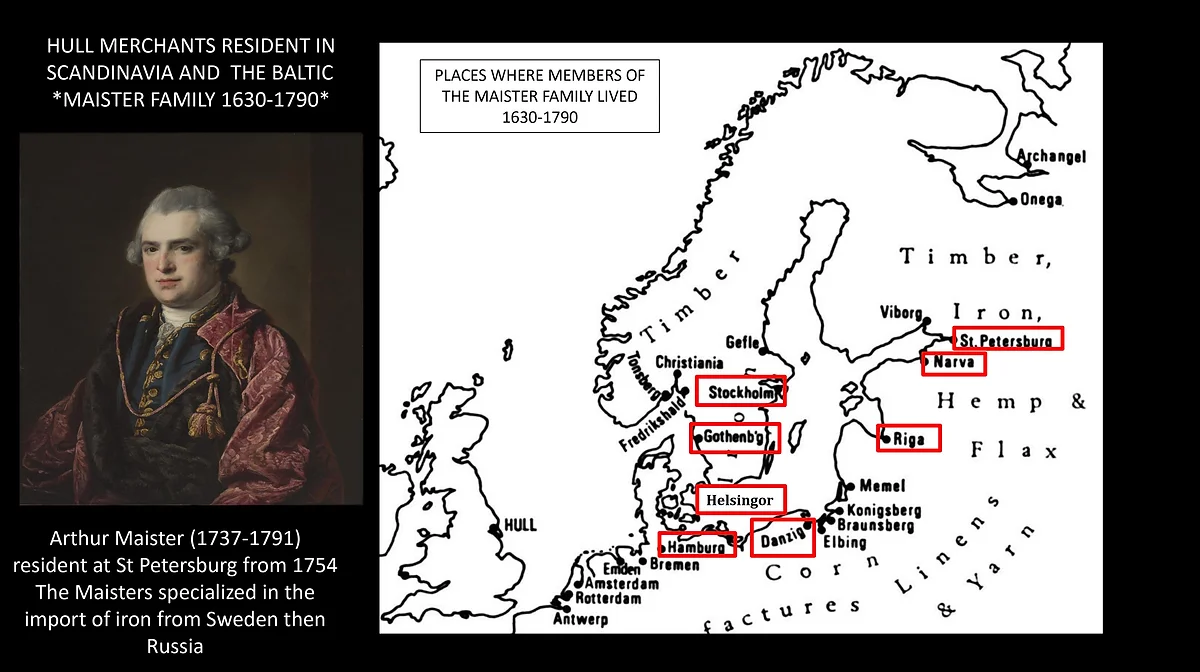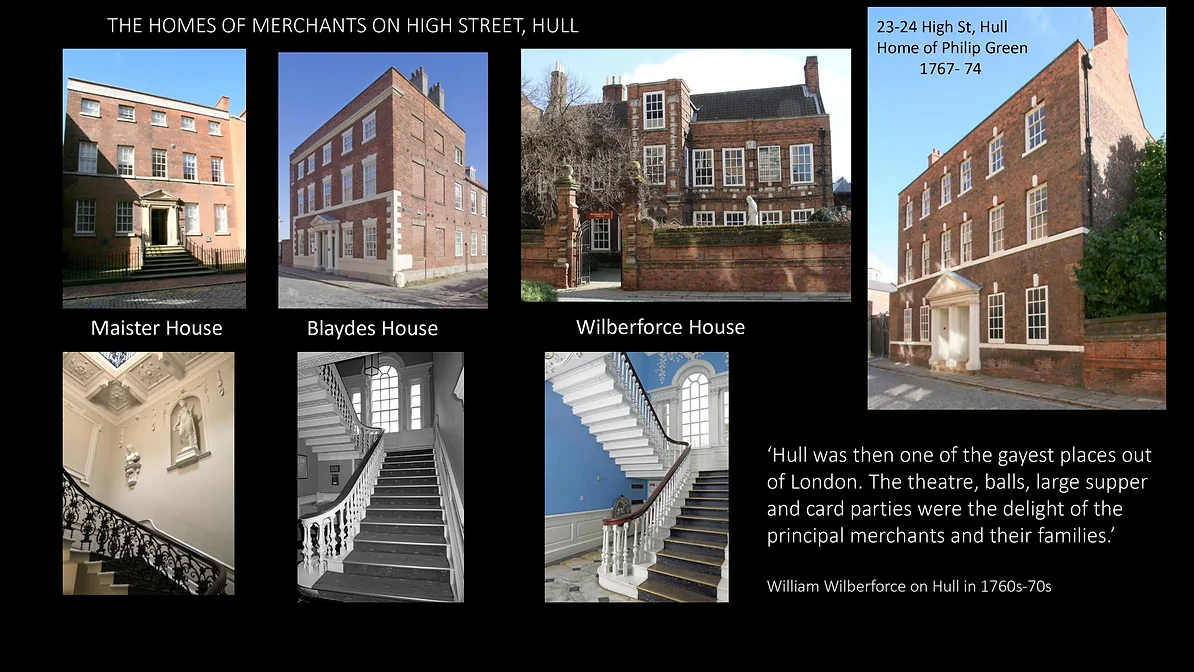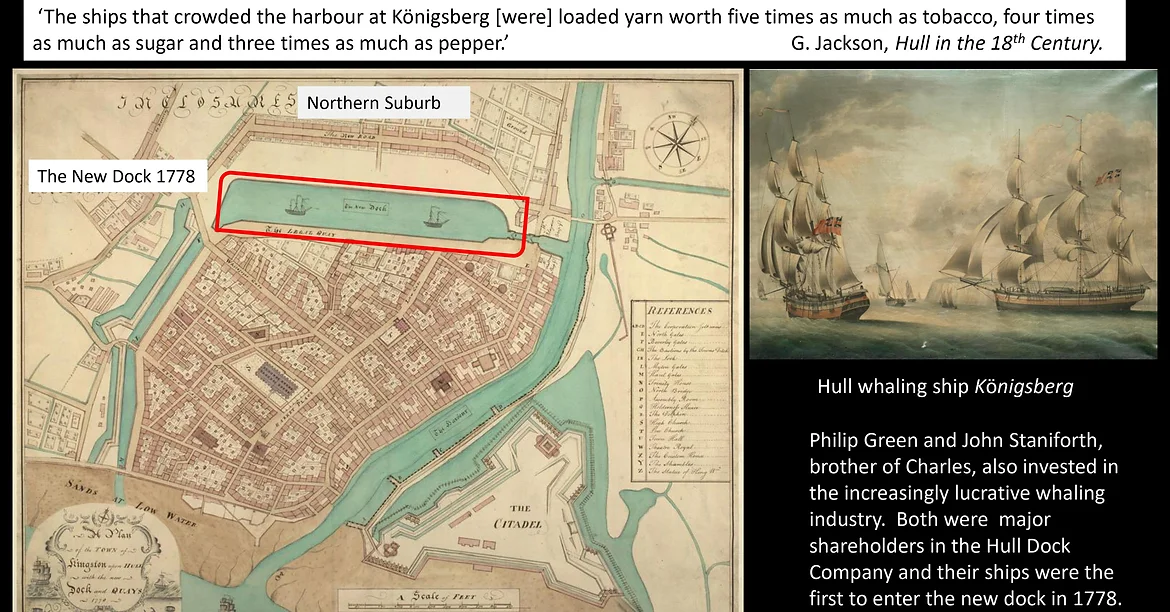Talk text revised 30 August 2021 with new information on Joseph Green’s origins.

1. INTRODUCTION
Four of the seven names engraved on the Kant glass, with the date 30 August 1763, are of men who came from the English port of Hull, or to give it its correct name, Kingston-upon-Hull. Two, Joseph Green and Robert Motherby, were permanent residents at Königsberg, and close friends of Kant, and are well known. The other two – Charles Staniforth, who had recently married Joseph Green’s sister, and John Chappell, were only visitors, but had probably known Kant for some years.
What were the origins of these four men, why were they in Königsberg, and what happened to them.
2. FAMILY ORIGINS IN HULL’s HINTERLAND
Hull’s great strengths as a port were its proximity to the Netherlands, Scandinavia and the Baltic and its vast accessible hinterland (by English standards)– accessible by an extensive river system which fed into the Humber estuary providing contact with much of the heartland of England, the birthplace of the Industrial Revolution. By the rivers and an increasing network of canals places as far away as Stoke on Trent and Birmingham, could be reached by water from Hull.

The fathers of Motherby, Staniforth and Chappell were evidently newcomers to Hull in the 1720s. The first two came from this hinterland. It is uncertain where the Green family originated, but John Green uncle of Joseph Green of Königsberg, Kants great friend, was living at the village of Swinefleet on the River Ouse – (Green circle), when he married a Hull girl at the nearby small market town of Snaith on the River Aire. (Orange circle) He was a mariner no doubt sailing one of the river boats transporting goods to and from Hull.
It was in and around Snaith that the Motherby family originated, and Robert Motherby’s father George was born nearby at the village of Hambleton (Purple circle), into a farming family.
In the mid 1720s Joseph Green, master mariner, father of Joseph of Königsberg, was resident in Hull (Blue circle) when he, his bother John and George Motherby and their wives became members of the Baptist church at Bridlington, on the coast, surprisingly some 40 or 50 miles from their homes. The Green and Motherby families were clearly well acquainted, and probably related. Soon after John Green and George Motherby moved to Hull where George played a part in founding a Baptist church.
Charles Staniforth’s family, also nonconformist moved from Sheffield to Hull at much the same time.
The origins of the Chappells is unclear although they are said to have been Huguenots that fled from France to Hull after the Revocation of Edict of Nantes in 1685. Benjamin Chappell, father of John, was captaining a ship sailing between Hull and Königsberg and elsewhere in the Baltic by the late 1730s.

3. HULL AND THE BALTIC
From its foundation the port of Hull traded with Scandinavia and the Baltic. In the 14th and 15th centuries trade was largely controlled by the Hanseatic merchants and in the late 16th to mid 17th century by the Dutch. The English Navigation Acts of the 1650s restricted trade between the Baltic and England to English ships and those from Scandinavian and Baltic ports.This helped make the century from the 1660s a ‘golden age’ for Hull merchants.
Chief exports to the Baltic were West Riding cloth and Derbyshire lead. Chief imports were iron, timber, hemp flax and yarn – The raw materials of the Industrial Revolution. Yarn, hemp and flax the main exports from Königsberg. At end of century 90% of East Prussian yarn went to Hull and then on to Manchester and the Lancashire mills.
The Green family had established trading links with Königsberg by the 1730s when John Green, was captaining a ship between Hull and the Baltic port. He may have been in partnership with, or working for, his brother Joseph Green, who had progressed from master mariner to merchant in Hull by 1731. He is probably the Joseph Green who married Ann Smith of Hornsea, East Yorkshire, in 1721. Joseph, merchant, and Ann had a least eight children, of which only five survived infancy, two sons Joseph and Philip, and three daughters Ann, Margaret and Elizabeth. It is probable that Joseph Green, junior, went to Königsberg to act as agent for his father’s firm and other Hull merchant houses by 1750. His brother Philip, Charles Staniforth (their future brother-in-law) and John Chappell were all sailing between Hull and Königsberg.
The Seven Years War 1756-63 affected trade in the Baltic with Russia and Prussia at War and Britain siding with Prussia. It was reported in July 1757 that Captain Philip Green had been taken by the Russian fleet, fortunately he was released after 24 hrs.
It was possibly in the early 1750s that the young Robert Motherby left Hull to become Joseph Green’s assistant at Königsberg. In January 1760 Joseph’s father Joseph Green senior, married as his second wife Robert Motherby’s aunt Jane. He died at Welton, near Hull, in 1762 leaving his son Philip as main beneficiary, but only money in trust for a sister to Joseph in Konigsberg.
Like Joseph Green there were numerous men from Hull merchant families resident agents in Scandinavia and Baltic at this time. Most notably the Maisters.

4. MAISTERS IN THE BALTIC
The Maisters, who specialised in importing iron from Sweden and Russia, probably the wealthiest of the merchant families in Hull had members in many different Baltic and Scandinavian ports in the 17th-18th centuries as shown marked in red here.
The portrait on the left of Arthur Maister who was resident at St Petersburg from 1754, he is shown in what is said to be Russian merchant cloak.
Was the firm of Green and Motherby the principal English trading house at Königsberg?
The Hull men coming to Königsberg must have been impressed by the city’s size and political and cultural importance.

5. KÖNIGSBERG AND HULL
Although they had similar origins – both founded in the 13th century by a king, Königsberg by King Ottakar of Bohemia and Kingston upon Hull by king Edward 1– and named after the king – king’s hill and king’s town – they were quite different in status and cultural life in 1760s.
Königsberg was at least 4 times the size of Hull, was capital of East Prussia and had a Cathedral and University Hull had no particular significance other that of a flourishing port and regional marketing centre, educational institutions were limited, and it had only two parish churches. It was beginning to rival York as the main town in Yorkshire, with population rising fast, and trade growing.
But Hull was not a backward, uncultured town and the leading merchants were wealthy and had important national as well as local connections.

6. HULL MERCHANT HOUSES
The houses of the grander merchants that still stand on High St, Hull, show something of their wealth and standing.
Maister House has the grandest of interiors with a magnificent staircase – Henry Maister, the builder was a Member of Parliament and amongst his friends was the architect and great patron of the arts Lord Burlington who advised on the staircase, along with his protégé William Kent. Wiliam Kent who was born at Bridlington, East Yorkshire, had changed his surname from Cant to Kent!
All the merchants wanted grand staircases even though some only looked out onto blank walls or warehouses.
Blaydes House, home of family of merchants and ship builders. The Bounty of Mutiny fame was built in one of their yards.
Wilberforce House, a 17th century Dutch style house was the birthplace of William Wilberforce in 1759.
As Wilberforce said of the town of his youth:
Hull was then one of the gayest places out of London. The theatre, balls, large supper and card parties were the delight of the principal merchants and their families.
The Hull men with their names on the Kant glass did not come from the merchant aristocracy but their fortunes were on the rise in the 1760s as Philip Green’ s home 24 High Street on the right suggests. It also has a grand staircase, the window overlooked the front garden of Wilberforce House. By then Philip Green was no longer serving as a ship’s captain but had become a shipowner and merchant, as had John Staniforth (Charles’s brother).
Shipowners, as distinct from merchants, were a new breed beginning to dominate English ports from the late 18th century.

7. WEALTH FROM EAST PRUSSIAN YARN
‘‘The ships that crowded the harbour at Königsberg loaded yarn worth five times as much as tobacco, four times as much as sugar and three times as much as pepper’. G.Jackson, Hull in the Eighteenth Century.
The export of yarn, hemp and flax through Hull was the foundation and continuing success of the Königsberg trading house of Green and Motherby, in which Immanuel Kant invested and the firm managed his finances. Yarn clearly made the fortunes of Joseph Green’s brother Philip and brother-in-law Charles Staniforth and his brother John Staniforth. Philip Green and John Staniforth also invested in Hull’s rapidly expanding whaling industry. The Hull whaling ship Königsberg must surely have been owned by one of them.
Green and Staniforth were amongst the original shareholders in the Hull Dock Company and when the New Dock opened in 1778 the largest in Britain at the time their ship were the first to enter in front of a crowd of 20,000 – that night Philip Green’s ship, the largest in the port, was illuminated with a grand transparent lantern and 1, 200 lights.
Up until the building of the Dock Hull had been confined within its medieval brick walls and 17th century defences – but as a circle of docks was built along the line of the walls – the walls were demolished and the town expanded rapidly to the north and west – Philip Green and John Staniforth built houses in the new fashionable Northern Suburb – with their homes opposite each other in Charlotte (now George) Street.

8. CONTINUING CONNECTIONS WITH HULL
On the far left is Philip Green’s new house.
Trade and family connections would have kept Joseph Green, who died in 1786, and Robert Motherby who died in 1801, and no doubt Immanuel Kant (died 1804), well informed of the developments in Hull. Robert Motherby’s unmarried sister Elizabeth lived in Hull until her death in 1797, and so did a nephew (George Hotham Motherby, d. 1805), a mariner son of Robert’s brother George, author of the New Medical Dictionary and pioneer of smallpox vaccination at Königsberg. George himself died at Beverley (8 miles from Hull) in 1793 and is buried in Beverley Minster.
Charles Staniforth, by then a successful London merchant, died in 1797 at Philip Green’s house in George Street, Hull. His will made in 1783 included bequests of £100 to his brother-in-law Joseph Green of Königsberg, merchant, and to ‘my friend Robert Motherby’. Joseph Green left Staniforth’s daughter £500 a substantial sum. Charles Staniforth’s son John became an MP for Hull and a Director of the Bank of England – and went bankrupt.
What of John Chappell the fourth of the Hull names on the Kant glass, who was said to have been ‘a courteous and gentle-natured man, slight, gracious and cultivated… [He] so loved books and poetry that he never put out to sea without his much-read copy of Milton’s Paradise Lost ‘. He remained a sea captain but in March 1775 on leaving Königsberg his ship John and Mary was totally lost in a storm. Chappell survived but died the following year, aged 36. He left a wife and young daughter, Ann, who much later married Matthew Flinders, the celebrated navigator who first charted much of the Australian coast.
Like Immanuel Kant at Kaliningrad, John Chappell’s son-in-law, Mathew Flinders has a university named after him at Adelaide, South Australia.
© David Neave 2021

